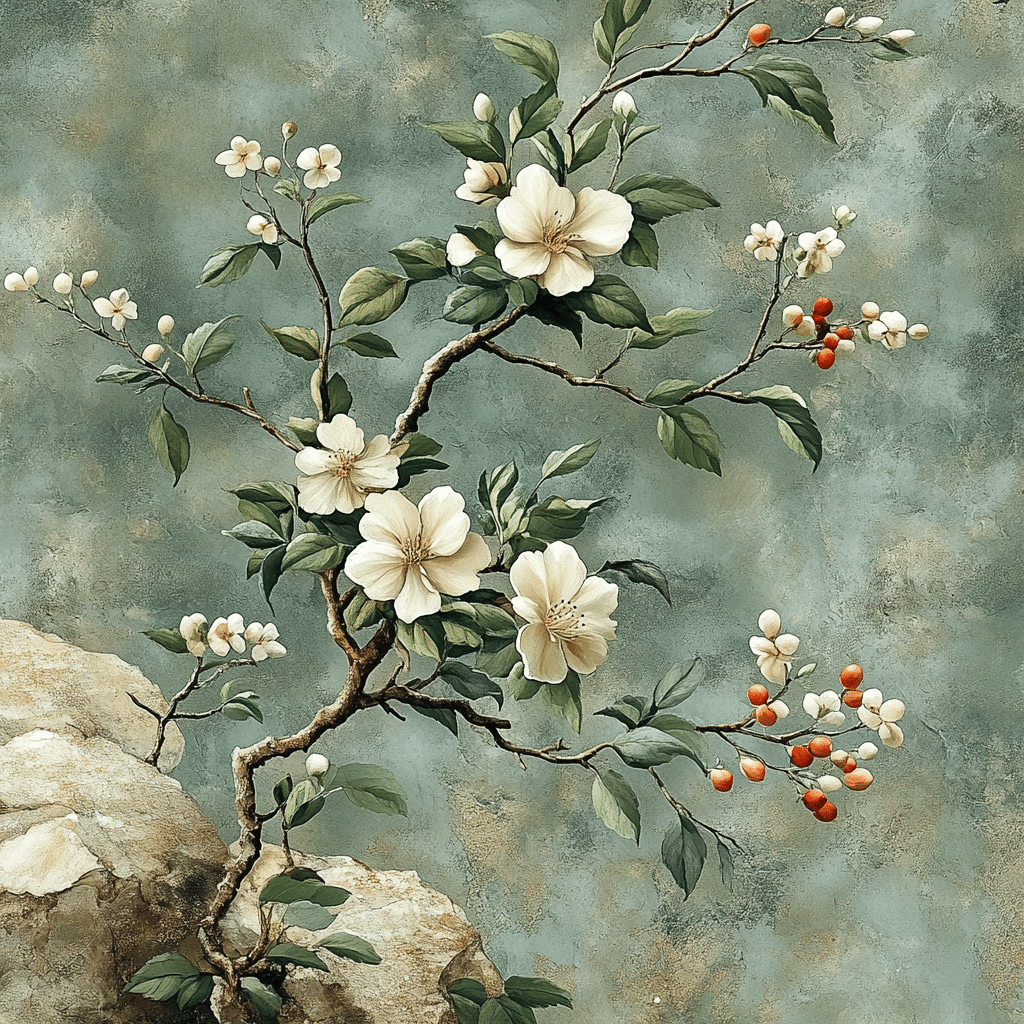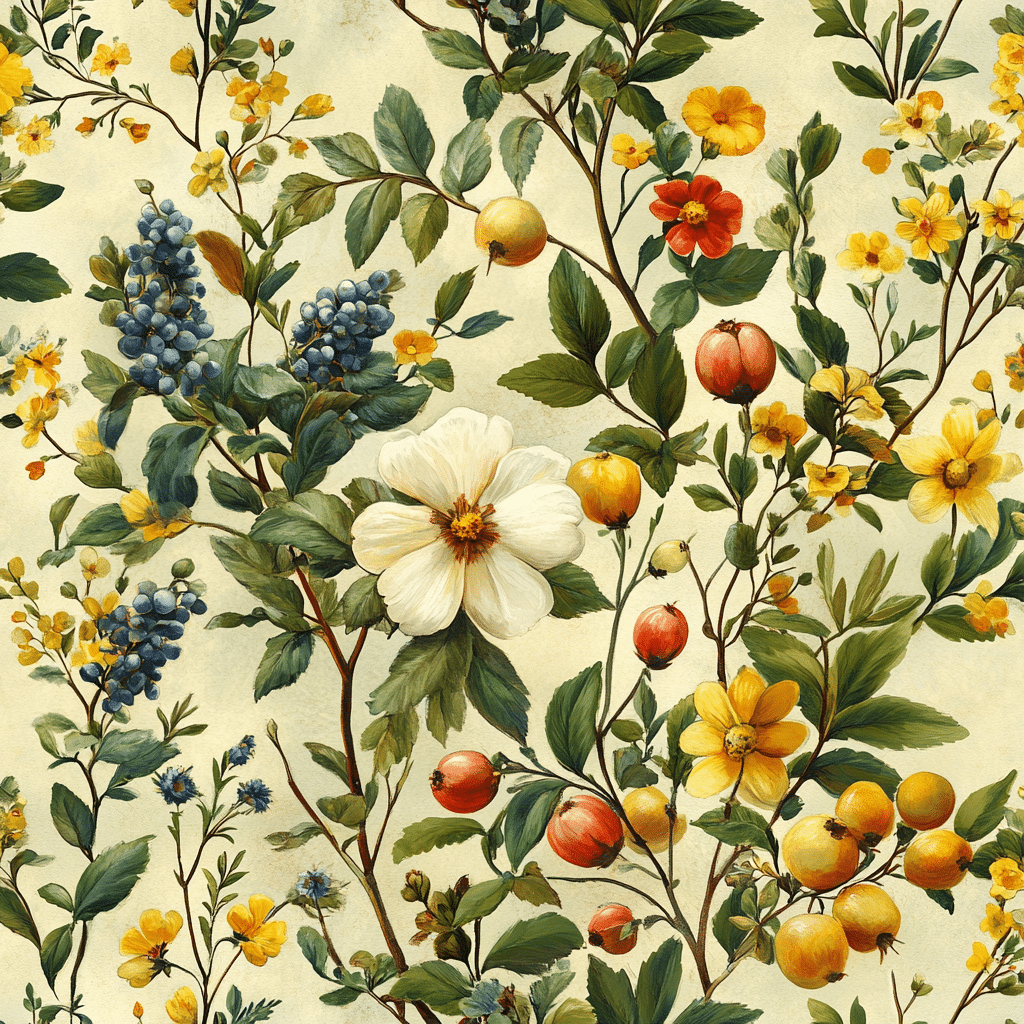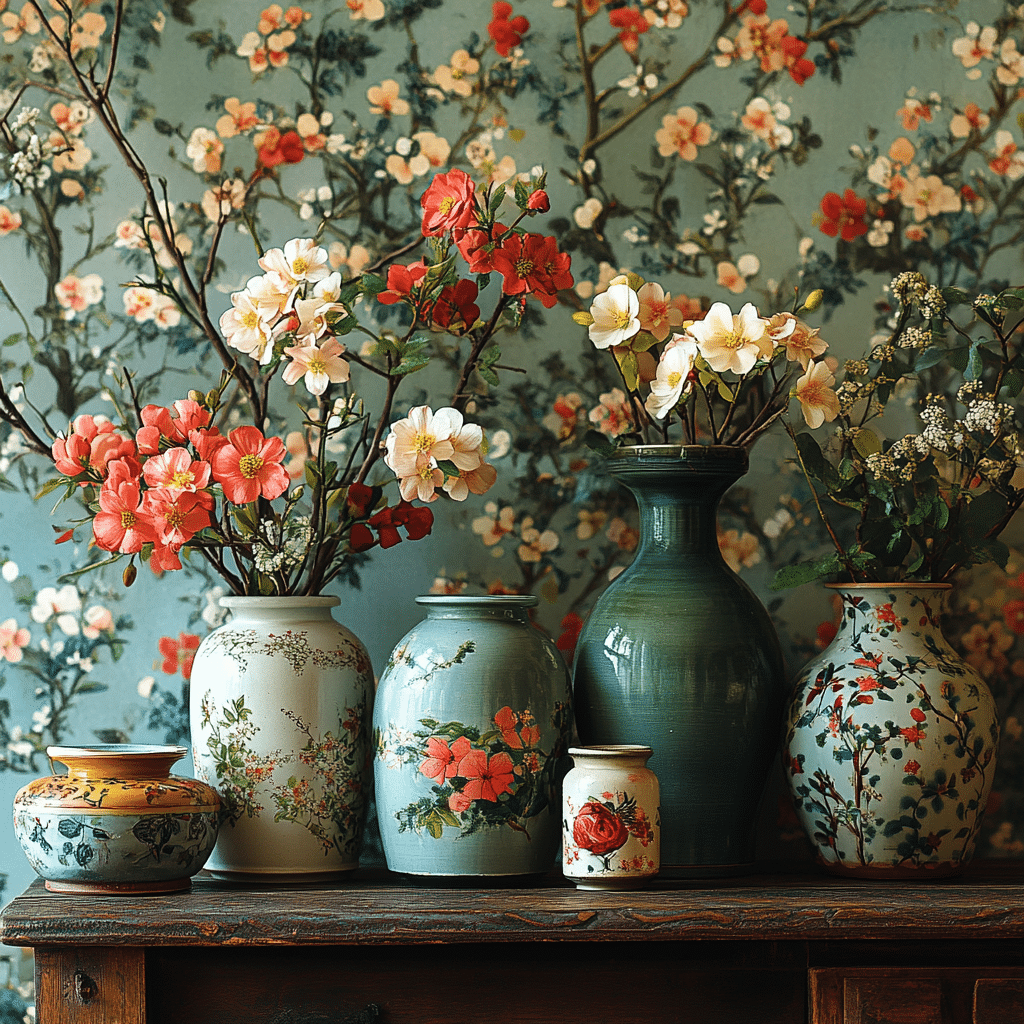The Evolution of Wallpaper Botany: A Design Journey Through Nature

1. The Intricate World of Wallpaper Botany
Wallpaper botany weaves together the beauty of nature with the art of design, reflecting society’s ever-changing relationship with the natural world. From delicate flowers to majestic trees, wallpapers have served as a canvas where artists express their love for flora and fauna. But it’s not just about pretty pictures; it’s about how these designs mirror cultural and historical trends.
The intricate world of wallpaper botany brings to light societal attitudes. In the 16th century, when the earliest wallpapers were initially crafted, they served a functional purpose as decoration, especially in smaller rooms of merchants’ houses. As these designs evolved, they gained popularity in the homes of the aristocracy in the 17th century and beyond. This shift illustrates how wallpaper design has adapted to reflect the values of different social classes.
Furthermore, wallpaper botany serves as an archive of human interaction with nature. Each motif tells a story—whether it’s the birch trees of the British countryside or the vibrant flowers inspired by Asian landscapes. By embedding these elements into our living spaces, we invite nature into our homes, creating environments that resonate with personal and collective histories.
2. Top 5 Iconic Brands Advancing Wallpaper Botany
As the trend continues to blossom, several brands have emerged as leaders in wallpaper botany, pushing the envelope of design while paying homage to nature. Here are five iconic names that have made a significant mark in this field:

3. Evolution of Botanical Designs in Wallpaper History
Tracing the history of botanical designs in wallpaper reveals fascinating shifts across centuries. The 17th century saw the rise of floral patterns, drawing inspiration from the surrounding environment. Artisans would often replicate nature, using techniques learned from Chinese artists who created wallpapers of birds and flowers on rice paper as early as 200 B.C.
During the Rococo period, the demand for asymmetric and flowing designs peaked. This led to lavish wallpapers that often included vivid greenery, floral arrangements, and playful motifs, transforming spaces into lush retreats. As advances in printing technology emerged, the accessibility of wallpaper surged, allowing broader societal implications that altered home decor for all classes.
The Arts and Crafts movement marked another turning point in wallpaper history. Connoisseurs like William Morris pushed for handmade designs that embraced organic motifs. This period fostered a deep appreciation for craftsmanship and sustainability, igniting a trend that resulted in wallpapers that celebrate the intricacies of the natural world.
4. The Role of Technology in Modern Wallpaper Botany
The 21st century has witnessed a technological revolution in wallpaper production, sparking a new era in wallpaper botany. Today’s advances in printing techniques allow for intricate designs and sustainable materials that weren’t previously possible. Brands like Spoonflower now utilize digital printing technology to replicate detailed textures and vibrant colors, enabling designers to blur the lines between art and nature.
With the rise of eco-friendly practices, the wallpaper industry is also shifting towards greener materials. Innovations like biodegradable inks, which replace traditional chemical-laden options, are now widely adopted. This commitment to sustainability not only benefits the environment but also attracts eco-conscious consumers eager for products that reflect their values.
As a result, contemporary wallpaper botany is at the forefront of design. Features like flocking—a fuzzy or velvet-like texture—and debossed patterns showcase the depth and dimension achievable through modern technology, adding layers of tactile interest to interior design that evoke a sensory connection to nature.
5. Cultural Reflections: Botanical Wallpaper in Global Contexts
Exploring the cultural significance of botanical wallpaper reveals how different regions interpret and celebrate nature through design. In Asian cultures, wallpaper often features symbolic plants like bamboo and cherry blossoms, which embody themes of resilience and renewal. These motifs present a spiritual connection to the earth, inviting serenity into living spaces.
By contrast, Western designs tend to focus on sprawling gardens and floral compositions, showcasing a different appreciation for nature. These wallpapers aim to recreate lush landscapes indoors, whisking inhabitants away to pastoral retreats even within urban settings. The cultural fabric of each region heavily influences these motifs, reflecting the diverse ways societies interact with their environment.
Despite these differences, the shared appreciation for botanical elements underscores a universal understanding of nature’s beauty. In examining wallpaper botany across cultures, it becomes clear: our desire to bring the outdoors in is a fundamental expression of our humanity.
6. The Psychological Impact of Botanical Patterns
Research highlights significant psychological benefits associated with nature-inspired designs in living spaces. Studies have shown that being surrounded by botanical imagery contributes to feelings of calmness and enhanced focus. This phenomenon supports the idea that wallpaper botany fosters a sense of tranquility, helping individuals cope with stress in their day-to-day lives.
Experts argue that wallpaper botany, when integrated into interiors, can simulate environments that resemble the great outdoors. This indoor mimicry positively influences mental well-being, making it a popular choice in therapeutic settings such as hospitals and wellness centers. Here, botanical wallpaper not only beautifies the space but also enhances the overall healing process.
As awareness of mental health continues to rise, more individuals are turning to wallpaper botany as a tool for personal and environmental balance. Whether it’s a serene garden scene or a bold botanical mural, the effects of these patterns extend far beyond aesthetics, making them essential components of modern design.
7. DIY Trends in Wallpaper Botany: A New Age of Personalization
The rise of DIY culture has opened new avenues for individuals to express their creativity through wallpaper botany. With platforms like Society6 and Etsy, amateur designers are embracing the ability to create custom wallpapers that showcase personal style. This surge in creativity reflects a growing recognition of the importance of self-expression in interior design.
Popular trends illustrate how wallpaper botany has become personalized. Consumers are increasingly opting for botanical-themed accent walls—transforming mundane spaces into vibrant showcases of flora. Additionally, bespoke murals that tell unique family stories or celebrate milestones bring a personal touch to homes, infusing spaces with meaningful narratives.
Moreover, social media platforms have fostered a community where design enthusiasts share their bespoke projects, celebrating individuality and creativity in wallpaper botany. This new age of personalization empowers individuals to curate their spaces, emphasizing how wallpaper design can transcend trends to become an intimate part of their lives.
Exploring the Future of Wallpaper Botany
Looking ahead, the relationship between botanical elements and interior design promises to thrive. Designers are increasingly experimenting with eco-friendly practices, sliding into a future where environmentally-conscious choices become the norm. As environmental awareness rises, we expect a surge in innovative, nature-inspired designs that will push the boundaries of wallpaper creativity.
Furthermore, the blending of fabrics and designs that mimic natural elements—like stone, wood, or foliage—will redefine traditional wallpaper concepts. This merging creates biophilic designs that foster a deeper connection to nature, evident in spaces that reflect both comfort and sustainability.
Overall, wallpaper botany is set to flourish, honoring its historical roots while adapting to contemporary trends—a harmonious balance that celebrates nature’s beauty and its integral place in our lives. As we continue to decorate our homes with nature-inspired designs, we cultivate an environment that nourishes both the mind and the spirit.
For more insights exploring captivating stories, check our section on Walton Le dale and discover the latest on Wasabi Root to delve deeper into the connections between nature and our everyday experiences.
In the enchanting world of wallpaper botany, the past enriches the present, and the present paves the way for the future—a truly beautiful design journey worth celebrating!
Wallpaper Botany: Discovering Nature’s Influence on Design
A Flourishing History
Did you know that wallpaper botany traces its roots back centuries to when nature was the primary muse for artists? Early wallpaper designs often reflected the flora of the time, weaving tales of gardens, landscapes, and botanical wonders into homes. Folks started using plant motifs to bring a touch of the outdoors inside. This blend of nature and artistry can really be seen in famous works, something like the classic Naruto poster provides a similar homage to character design and theme. As designers utilized native plants, they cultivated a vibrant visual language that transformed dull walls into canvases of lush beauty.
Trivia from the Tropics
Wallpaper botany isn’t just about pretty visuals; it also reveals a deeper connection to nature. Some wallpapers featured exotic plants that were imported from distant lands, much like the excitement people feel today when they hear news like Is Carrie underwood pregnant? These patterns often told stories of exploration and discovery, captivating imaginations across generations. Interestingly, the art of wallpaper botany also led to the classification of plants and flowers, much like how the Fushiguro in fiction explore deeper themes in storytelling.
Culture and Craft
Fast forward to today’s world of design, and wallpaper continues to echo this botanical legacy. In fact, the revival of vintage designs has sparked a renewed interest in wallpaper botany, as people aim to recreate the warmth of past interiors. This trend is reminiscent of events like the rise of digital media, where platforms like Warfield bring fresh perspectives to established narratives. Moreover, innovative techniques used by artists ensure that each print is as intricate as a Max Hartley story, proving that the past truly influences the present.
In revisiting this compelling niche of design, we tap into a rich tapestry of history, art, and nature—a combination that keeps wallpaper botany alive and buzzing with creativity. Whether you’re an avid decorator or simply appreciate art, there’s always something new to discover!

What was wallpaper originally made for?
Wallpaper was originally made to decorate smaller rooms and cupboards in merchants’ houses, rather than in the grand homes of the aristocracy.
What is wallpaper pattern in math?
Wallpaper patterns in math refer to the study of repeating designs and their geometric arrangements, similar to how wallpapers create visual texture in spaces.
What is the origin of wallpaper?
The origin of wallpaper dates back to China around 200 B.C., where it featured painted designs of birds, flowers, and landscapes on rice paper, and the technique spread to the Middle East through prisoners.
What is fuzzy wallpaper called?
Fuzzy wallpaper is called flock wallpaper, which has a soft, velvety texture that adds a cozy feel to any room.
Why is wallpaper no longer used?
While wallpaper is still used today, it’s become less common in some areas due to the popularity of paint and easier installation methods.
What did wallpaper look like in the 1950s?
In the 1950s, wallpaper featured bold patterns, often with floral designs, geometric shapes, and vibrant colors that reflected the upbeat spirit of the era.
Why are there only 17 wallpaper groups?
The 17 wallpaper groups are classification categories based on design, texture, and application techniques, helping manufacturers and consumers navigate the variety of options available.
What is the formula for wallpaper?
The formula for wallpaper often includes specific proportions for the paper dimensions, pattern repeats, and adhesive guidelines to ensure a proper fit and application on walls.
What is the rosette pattern?
The rosette pattern consists of circular floral designs, typically arranged symmetrically, creating a pleasing, decorative look in wallpaper.
What do Americans call wallpaper?
Americans commonly call wallpaper simply “wallpaper,” just as it’s referred to in many other English-speaking countries.
What are the disadvantages of wallpaper?
The disadvantages of wallpaper include difficulty in installation, potential issues with peeling, and challenges when it comes to removing or changing designs, making paint more desirable for some.
What did wallpaper look like in the 1800s?
In the 1800s, wallpaper featured intricate designs, with patterns often depicting nature, landscapes, and scenes that were colorful and detailed, reflecting the art styles of the time.
What is French wallpaper called?
French wallpaper is often called “papier peint,” and it’s known for its luxurious designs, intricate patterns, and hand-painted techniques that highlight French artistry.
What is Zen wallpaper?
Zen wallpaper typically features calming designs, often inspired by nature or minimalist aesthetics, aimed at creating a peaceful environment to promote relaxation.
What are the white borders on walls called?
The white borders on walls are commonly referred to as crown molding or baseboards, which enhance the look of the room while covering gaps between the wall and ceiling or floor.
What is the purpose of wallpaper?
The purpose of wallpaper is to add visual interest and texture to walls, helping to enhance the overall decorative style of a room.
Why did people use wallpaper instead of paint?
People used wallpaper instead of paint because it offered various patterns and textures, allowing for more creativity and personalization in home decor.
What did wallpaper paste used to be made of?
Wallpaper paste used to be made from natural ingredients like flour, starch, and water, providing a sticky solution to adhere wallpaper to walls.
What is the history of hand painted wallpaper?
The history of hand-painted wallpaper is rich, originating in Europe during the 18th century, where artisans would create custom designs, making each piece unique and highly sought after.



